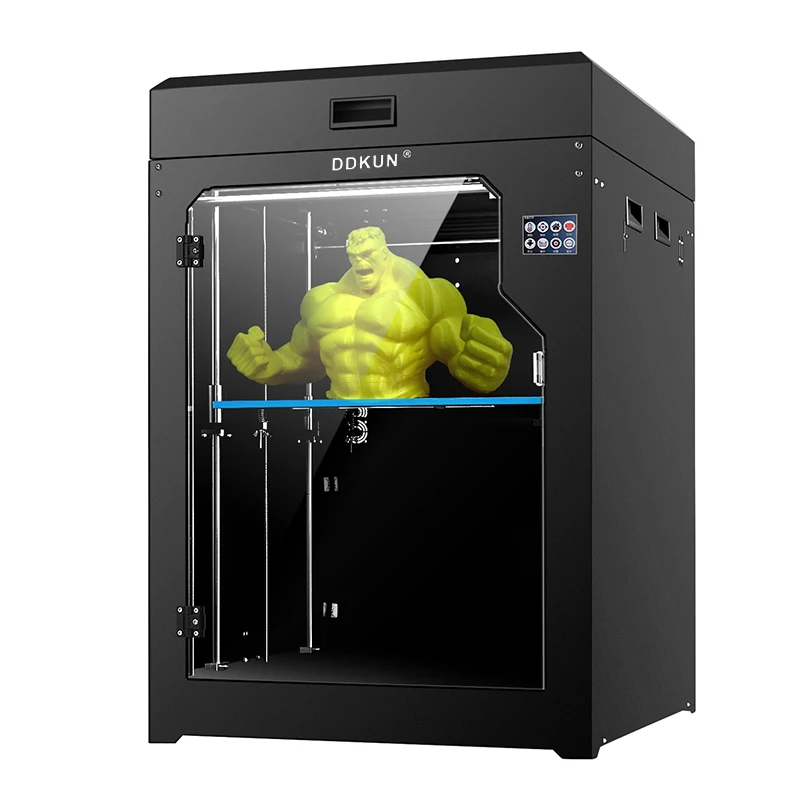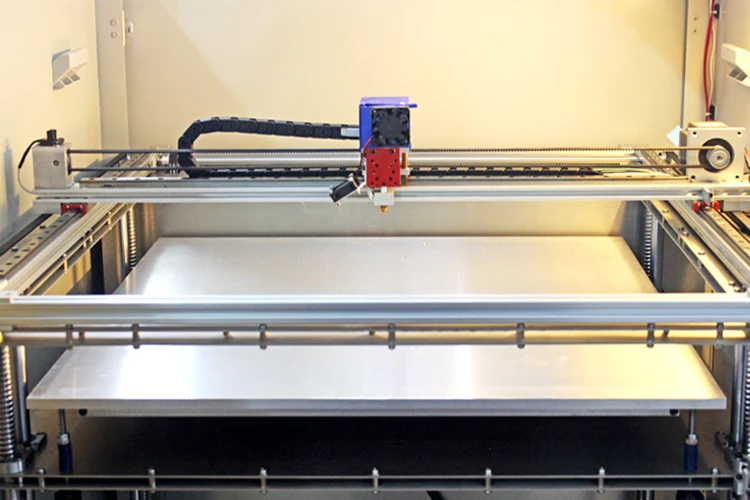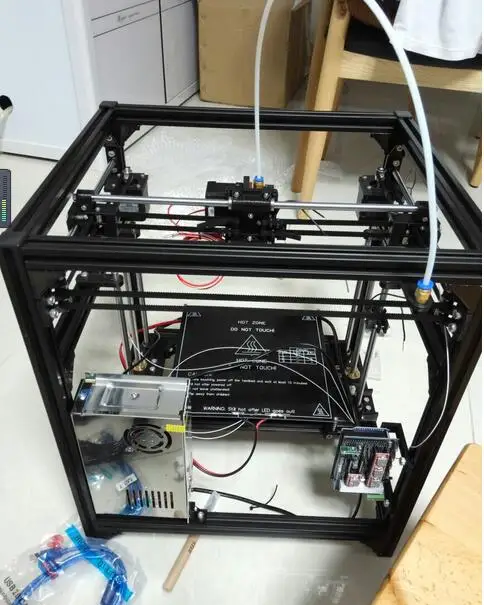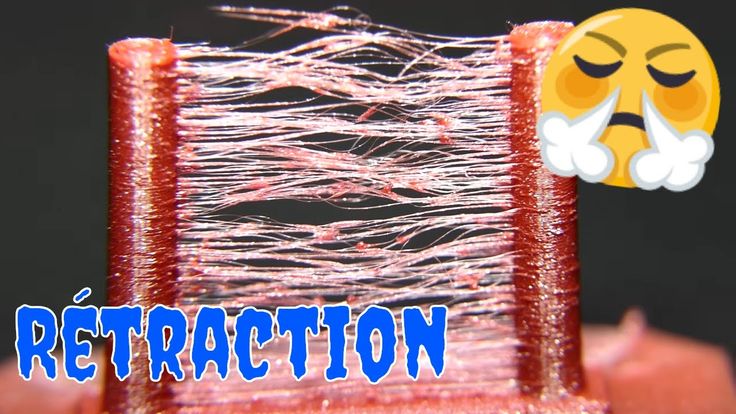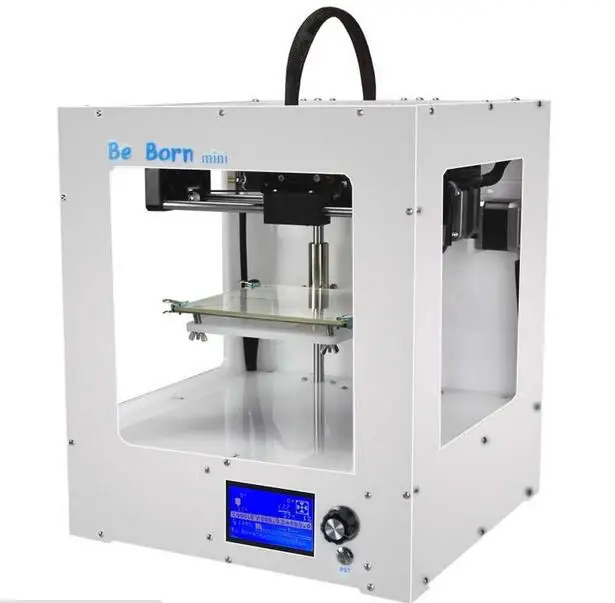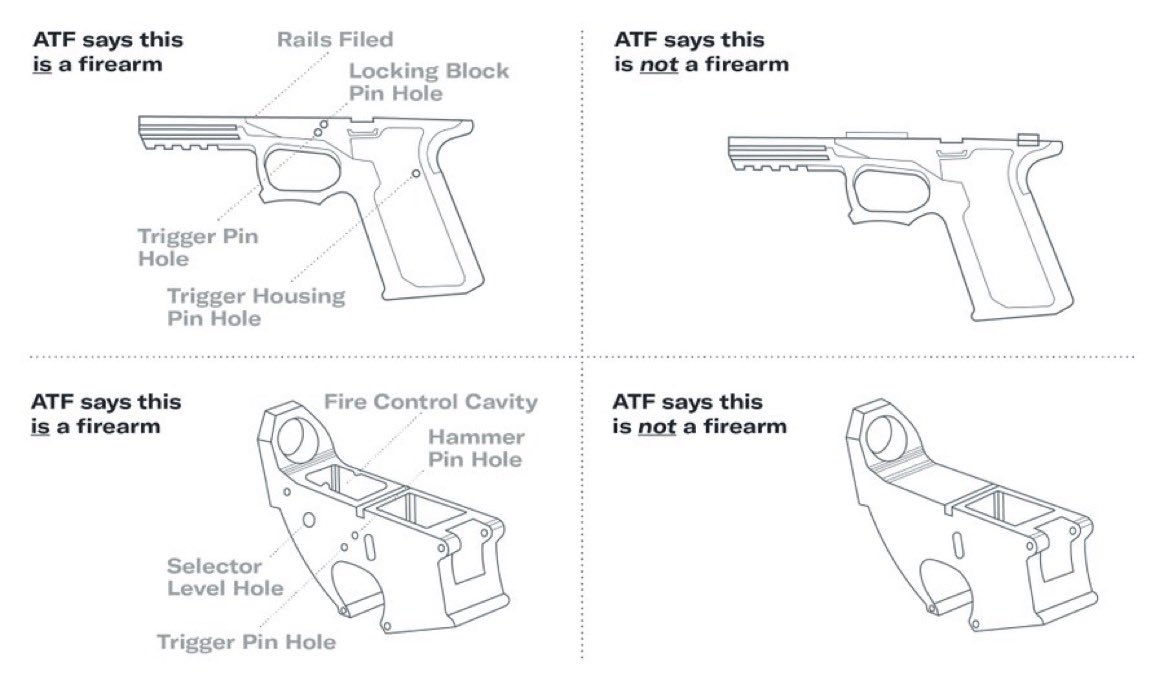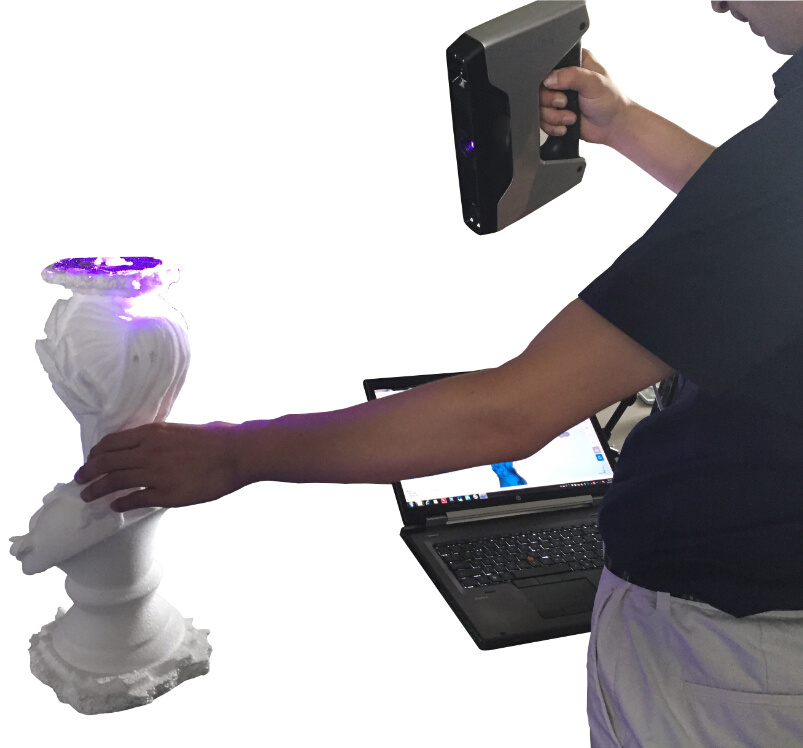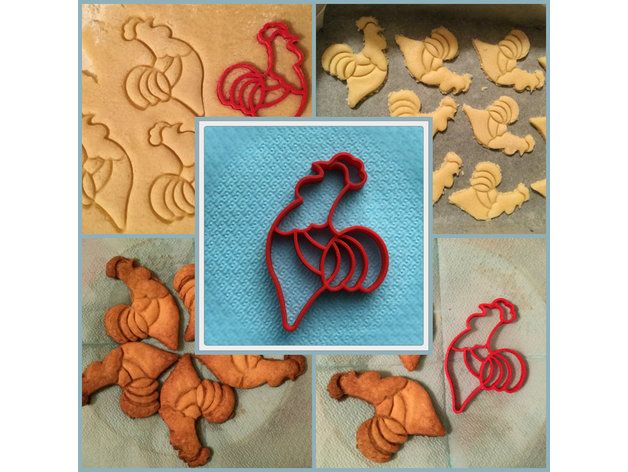Cheap large format 3d printer
BIG volumes starting at $310
Large 3D printers for consumers used to be hard to find. Today, there are many different low-cost brands that offer affordable large volume 3D printing. Check out our selection and large volume 3D printer buying guide below!
Table of contents
What’s the best large 3D printer when you’re on a low budget?
Big, affordable 3D printers under $1,000
CR-10 S5
Duplicator 9
CR-10 Max
Chiron (Kit)
Predator
X5S (Kit)
A30
U20 (Kit)
Sidewinder X1
CR-10 V2
A5S
Construction
Structure: cartesian, delta, or CoreXY
Material support
Features
Customer support
FAQ
What’s the best large 3D printer when you’re on a low budget?
Build volume is generally an area where “bigger is better” if it’s within your budget. A large 3D printer will allow you to print anything from a TPU smartphone case to a full-sized stormtrooper helmet made from ABS.
As you can imagine, large build sizes are especially useful if you need to 3D print big objects. With a smaller desktop 3D printer, you’d have to break down your big 3D model into multiple parts and print them separately, to assemble or glue them together afterward. Big 3D printers are also great for printing a series of objects in one go.
Our guide focuses on 3D printers with a large build area that is available for under $1000. While some consider any printer beyond 250 x 250 x 250 mm to be in the oversized class for home use, our picks all exceed 300 x 300 x 300 mm.
Big, affordable 3D printers under $1,000
| Brand | Product | Build size | Country | Price Approximate starting prices based on supplier-provided information and public data. Prices may vary by region, over time and do not include additional products or services (taxes, shipping, accessories, training, installation, …). | |
|---|---|---|---|---|---|
| Alfawise | U20 (Kit) | 300 × 300 × 400 mm11.81 × 11.81 × 15.75 in | – | $ 310292 €257 £41,778 ¥ | Contact |
| Geeetech | A30 | 320 × 320 × 420 mm12.6 × 12.6 × 16.54 in | – | $ 330311 €274 £44,473 ¥ | Contact |
| Tronxy | X5S (Kit) | 330 × 330 × 400 mm12.99 × 12.99 × 15.75 in | – | $ 360339 €298 £48,516 ¥ | Contact |
| Artillery 3D | Sidewinder X1 | 300 × 300 × 400 mm11.81 × 11.81 × 15.75 in | – | $ 399499 €331 £53,772 ¥ | Contact |
| JGAURORA | A5S | 305 × 305 × 320 mm12.01 × 12.01 × 12.6 in | – | $ 399376 €331 £53,772 ¥ | Contact |
| ANYCUBIC | Chiron (Kit) | 400 × 400 × 450 mm15.75 × 15.75 × 17.72 in | – | $ 499470 €414 £67,249 ¥ | Contact |
| Creality | CR-10 V2 | 300 × 300 × 400 mm11.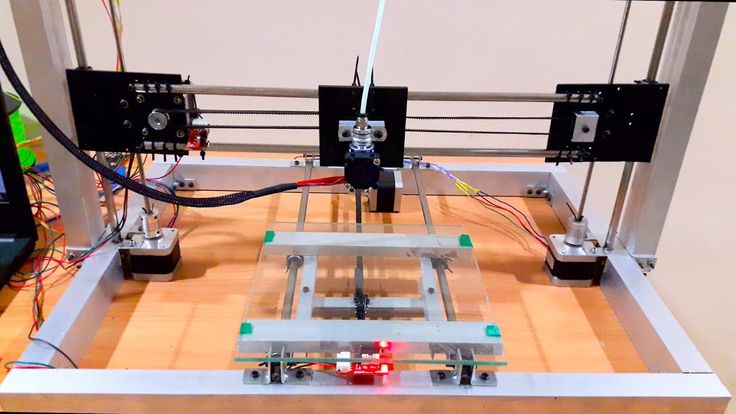 81 × 11.81 × 15.75 in 81 × 11.81 × 15.75 in | – | $ 519489 €430 £69,945 ¥ | Contact |
| ANYCUBIC | Predator | 370 × 370 × 455 mm14.57 × 14.57 × 17.91 in | – | $ 588554 €487 £79,244 ¥ | Contact |
| Wanhao | Duplicator 9 | 500 × 500 × 500 mm19.69 × 19.69 × 19.69 in | – | $ 649611 €538 £87,464 ¥ | Contact |
| Creality | CR-10 S5 | 500 × 500 × 500 mm19.69 × 19.69 × 19.69 in | – | $ 759715 €629 £102,289 ¥ | Contact |
| Creality | CR-10 Max | 450 × 450 × 470 mm17.72 × 17.72 × 18.5 in | – | $ 1,1001 036 €912 £148,245 ¥ | Contact |
Expand to see more specs
The products in the table are ranked by price (low to high).
| Product | Brand | Build volume | Build size | Price Approximate starting prices based on supplier-provided information and public data. Prices may vary by region, over time and do not include additional products or services (taxes, shipping, accessories, training, installation, …). | |
|---|---|---|---|---|---|
| U20 (Kit) | Alfawise | 36 L | 300 × 300 × 400 mm11.81 × 11.81 × 15.75 in | $ 310292 €257 £41,778 ¥ | Contact manufacturer |
| A30 | Geeetech | 43.01 L | 320 × 320 × 420 mm12.6 × 12.6 × 16.54 in | $ 330311 €274 £44,473 ¥ | Contact manufacturer |
| X5S (Kit) | Tronxy | 43.56 L | 330 × 330 × 400 mm12.99 × 12.99 × 15.75 in | $ 360339 €298 £48,516 ¥ | Contact manufacturer |
| Sidewinder X1 | Artillery 3D | 36 L | 300 × 300 × 400 mm11.81 × 11.81 × 15.75 in | $ 399499 €331 £53,772 ¥ | Contact manufacturer |
| A5S | JGAURORA | 29.77 L | 305 × 305 × 320 mm12.01 × 12.01 × 12.6 in | $ 399376 €331 £53,772 ¥ | Contact manufacturer |
| Chiron (Kit) | ANYCUBIC | 72 L | 400 × 400 × 450 mm15.75 × 15.75 × 17.72 in | $ 499470 €414 £67,249 ¥ | Contact manufacturer |
| CR-10 V2 | Creality | 36 L | 300 × 300 × 400 mm11. 81 × 11.81 × 15.75 in 81 × 11.81 × 15.75 in | $ 519489 €430 £69,945 ¥ | Contact manufacturer |
| Predator | ANYCUBIC | 62.29 L | 370 × 370 × 455 mm14.57 × 14.57 × 17.91 in | $ 588554 €487 £79,244 ¥ | Contact manufacturer |
| Duplicator 9 | Wanhao | 125 L | 500 × 500 × 500 mm19.69 × 19.69 × 19.69 in | $ 649611 €538 £87,464 ¥ | Contact manufacturer |
| CR-10 S5 | Creality | 125 L | 500 × 500 × 500 mm19.69 × 19.69 × 19.69 in | $ 759715 €629 £102,289 ¥ | Contact manufacturer |
| CR-10 Max | Creality | 95.18 L | 450 × 450 × 470 mm17.72 × 17.72 × 18.5 in | $ 1,1001 036 €912 £148,245 ¥ | Contact manufacturer |
Overview of the best large desktop 3D printers
Below you’ll find more details about each large 3D printer.
The Creality CR-10 S5 is one of the best large scale 3D printer options in this class with a build volume of 500 x 500 x 500mm. With only a few sections, it’s also one of the easier machines to assemble, and the build quality is a nice upgrade over the base model CR-10.
With only a few sections, it’s also one of the easier machines to assemble, and the build quality is a nice upgrade over the base model CR-10.
Dual Z rod screws ensure excellent accuracy along on this open-source machine, and the hot end can handle PLA, ABS, and TPE. As it’s essentially a larger version of the CR-10S, you can expect features like a heated bed, auto-resume, and filament runout detection as well.
Contact manufacturer Add to comparison
Wanhao is one of the more popular brands with makers looking for an affordable machine, and the Duplicator 9 500 (D9 500) is a large 3D printer with an array of excellent features. It’s well-built with an extruded aluminum frame and easy to use thanks to an integrated touchscreen display and auto-resume.
The MK10 full metal hotend is another highlight of this printer. It can reach 300°C, which allows you to print with a broader range of materials. Automatic bed leveling and a heated bed with an anti-backlash rolling system are also great features.
Contact manufacturer Add to comparison
The CR-10 Max is another new addition to Creality’s arsenal and a printer worthy of being in the large format class for average consumers. The spacious 450 x 450 x 470mm build volume gives you plenty of room to work, and several areas of this machine have seen a substantial upgrade over standard models in the CR-10 lineup.
Smooth prints on a large scale are possible with the CR-10 Max thanks to its unique Z-axis bracing system that Creality calls “the Golden Triangle”. Automatic bed leveling and the touchscreen-based UI are also great features to have on hand as well as the split-flow power supply, which heats up the bed in an instant.
Contact manufacturer Add to comparison
ANYCUBIC has several impressive 3D printers in their lineup, and they recently jumped into the large scale range with the Chiron. Given its price point and the build area compared to some of the printers on our list, it’s certainly an option for one of the best large 3D printer under $1000.
The ANYCUBIC Chiron keeps things simple with a classic design featuring a top-notch heated print bed and a 25-point leveling system. The single extruder and hot end are rated to work with ABS, HIPS, and TPU as well as PLA on this affordable big 3D printer.
Contact manufacturer Add to comparison
While a little smaller than the Chiron, the ANYCUBIC Predator is still one of the best big 3D printers under $1000. It’s just as capable as its larger sibling and is the perfect choice if you prefer Delta 3D printers to Cartesian-style machines.
The Predator offers up one of the largest build areas of any Delta printer in this range. It sports a quick heating Ultrabase Pro platform that can reach 100°C and has a 37-point auto-leveling system. An integrated touchscreen and filament sensors are also features to appreciate with the ANYCUBIC Predator 3D printer.
Contact manufacturer Add to comparison
TronXY is a company out of China that specializes in producing affordable machines.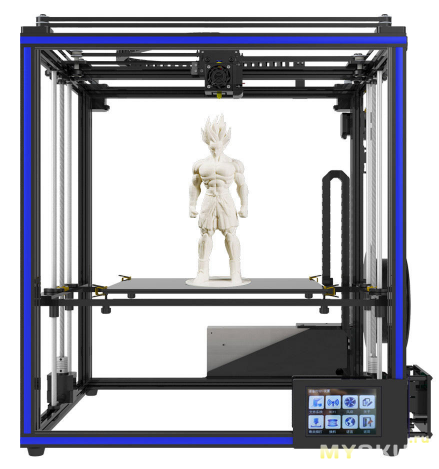 Their entry onto our list of the best large 3D printers under $1000 is the TronXY X5S. It’s a DIY kit with excellent reviews and a very stable structure.
Their entry onto our list of the best large 3D printers under $1000 is the TronXY X5S. It’s a DIY kit with excellent reviews and a very stable structure.
The TronXY X5S is a CoreXY printer with a sturdy metal frame. That adds stability while you print and the auto-leveling system ensures accuracy. Filament runout detection, a heated bed, and a touchscreen are included, but their customer support isn’t quite up to the standards of other manufacturers in this class.
Contact manufacturer Add to comparison
Fans of the popular CR-10 will recognize this printer and appreciate the price. The Geeetech A30 is a big desktop 3D printer with a frame built from extruded aluminum parts. It prints materials like ABS, Nylon, and Woodfill with ease, which is ideal when you’re looking for a large 3D printer.
This large FDM 3D printer is a capable machine with an ample build volume and heated bed sporting a silicone carbine glass plate. Makers found the colorful 3.2-inch touchscreen a pleasure to use, although some had issues with software and offsets. Customer service and community support are both solid with this brand of 3D printer.
Customer service and community support are both solid with this brand of 3D printer.
Contact manufacturer Add to comparison
The Alfawise U20 is a Gearbest 3D printer and a substantial upgrade over the previous model. It’s accurate and also one of the cheapest large 3D printers on our list, although missing a few features found on more expensive big 3D printers.
With a large build volume of 300 x 300 x 400mm, the Alfawise U20 can bring large creations to life whether you prefer PLA or TPU. It has all the standard bells & whistles, including a color touchscreen, but bed leveling is handled manually. Aside from a few awkward design decisions and a noisy fan, the U20 provides a lot of bang for your buck.
Contact manufacturer Add to comparison
Artillery has produced several popular printers over the past few years, including the Sidewinder X1. This sleek printer is quieter than other 3D printers with a large build area and has a heated bed capable of hitting its maximum temperature in around 2 minutes.
The Artillery Sidewinder X1 can print a wide range of materials with a direct drive extruder and Titan-style hot end. An extruded aluminum frame keeps the X1 stable regardless of your print speed, while the color touchscreen makes the machine a joy to use. Cable management and the synchronized Dual Z system are two additional perks of the X1.
Contact manufacturer Add to comparison
The Creality CR-10 V2 is one of the newest variants of the company’s extremely popular CR-10 3D printer. The new model shares plenty of similarities with the original but is a better option if you don’t need a printer quite as large as the CR-10 Max.
One advantage of the CR-10 V2 is the separate control box, which is ideal if you want to add an enclosure. The “Golden Triangle” design and aluminum frame ensure stability while 3D printing, and the dual-port hot end cooling fans help dissipate heat. Other noteworthy features include filament runout detection and auto-resume.
Contact manufacturer Add to comparison
The JGAurora A5S is a 3D printer that proves good things come in small packages.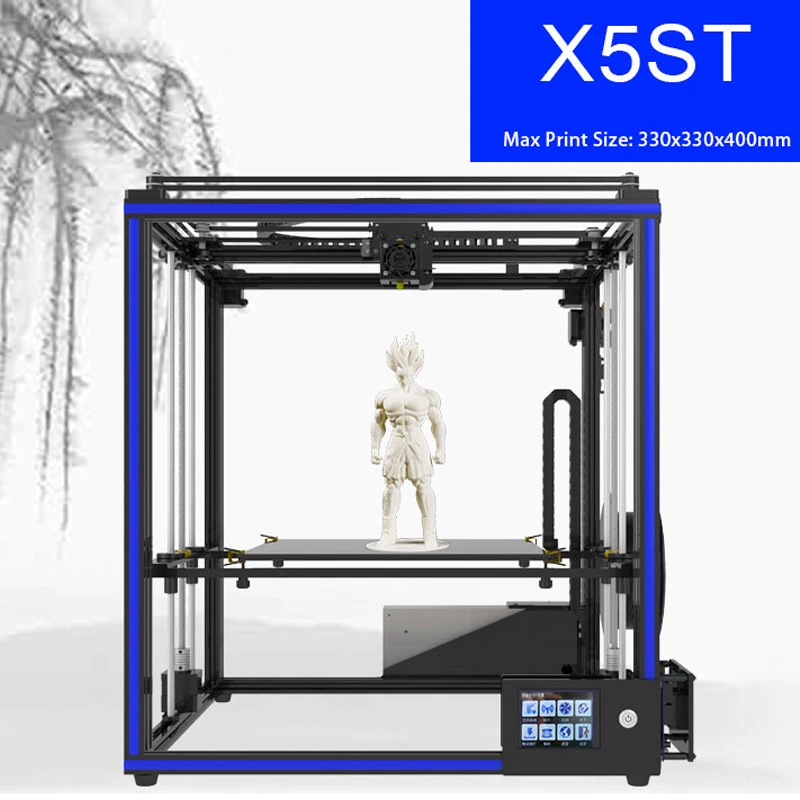 This machine leaves a smaller footprint behind than many of its competitors, but still has a large build volume for your creations at 305 x 305 x 320mm.
This machine leaves a smaller footprint behind than many of its competitors, but still has a large build volume for your creations at 305 x 305 x 320mm.
This 3D printer has a black diamond glass plate and a heated bed with a maximum temperature of 110°C. A 32-bit motherboard keeps things running smoothly, and we’re fans of discreet cable management system as well. Calibration is semi-manual, but the overall setup is quick and straightforward with the A5S.
Contact manufacturer Add to comparison
How to find the best large 3D printer for under $1000
There are a lot of exciting machines available at this price point, which makes it difficult to narrow things down. Here are a few key areas you’ll want to take into consideration before you choose your large 3D printer.
Construction
Build quality is important with any type of 3D printer regardless of the price. Well, it’s even more crucial with a large 3D printer as you’ll need a stable machine that can handle massive prints, which can take hours or days.
All of the key components– especially the mainframe– should be made from metal (ie. aluminum). Plastic 3D printed parts on budget-friendly printers are common, but can easily be reprinted and replaced whereas frames and aluminum parts are far more expensive to upgrade. Buying a printer that’s built like a tank is never a bad idea.
You also need to keep the overall size of the printer in mind, as 3D printers with large build areas are going to have a larger footprint. Check the dimensions of each machine if you are short on space, and keep in mind that some of them have separate control boxes that take up extra room.
Structure: cartesian, delta, or CoreXY
If you’re looking for a 3D printer in the $200 to $300 range, you’re typically limited to one style of printer. When it comes to large 3D printers under $1000, there are three main styles to choose from: Cartesian, Delta, or CoreXY 3D printers.
- Cartesian (Prusa i3 type) – These machines are the most common, popular, and easy to alter.
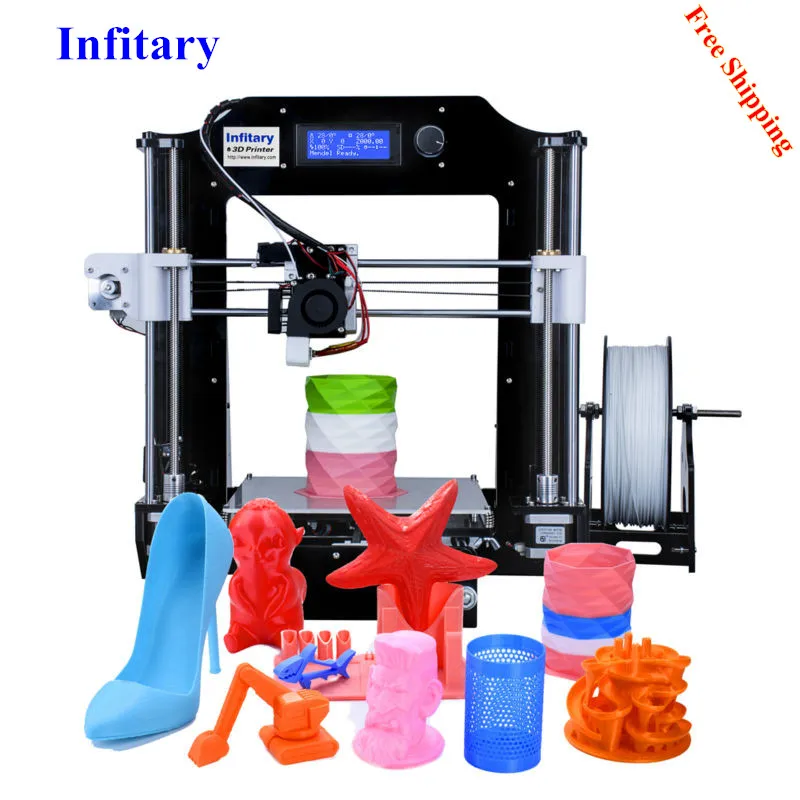 In this price range, they also tend to be the ones that offer the biggest volumes. The print head moves up and down, and from right to left, while the build bed goes forwards and backward.
In this price range, they also tend to be the ones that offer the biggest volumes. The print head moves up and down, and from right to left, while the build bed goes forwards and backward. - Delta – This triangular type of 3D printer provides a cylindrical build volume, and is, therefore, taller than they are wide. The print head has more freedom to move as it is mounted at the center of three “arms”. The print bed stays in place, which eliminates wobbling issues that you can potentially find on an i3-type printer.
- CoreXY – It is a kind of cartesian 3D printer, but it looks like a cube. The printer itself takes up less room than a Prusa i3 type 3D printer since the fixed bed doesn’t require space to move back and forth. These printers can be tricky to assemble and tweak.
Material support
Material support comes down to two things – the hot end (nozzle) and the print bed. That means you need to consider the type of hot end that’s included with the printer as well as the temperatures it’s capable of reaching.
That means you need to consider the type of hot end that’s included with the printer as well as the temperatures it’s capable of reaching.
An all-metal hot end is the best choice for printing at higher temperatures or using exotic materials like LAYCeramic or Proto-Pasta’s conductive PLA. Nowadays, all-metal nozzles are a relatively standard feature on many large 3D printers.
However, if you do choose a printer with a brass nozzle, you won’t be able to print abrasive materials like carbon fiber without seriously damaging the hotend. Ordering a new nozzle and swapping the old one out isn’t too complicated though!
You will also find a heated bed find on the best big 3D printers, but how well they work and how quickly they will reach optimum temperatures can vary. A heated print bed will allow you to print with a wider range of materials too (TPU, Nylon, …) whereas without heating the platform you can pretty much only print PLA.
Features
With smaller machines, it’s not uncommon to find things like Wi-Fi connectivity or a dual extruder, but you won’t find either of those on large-sized 3D printers under $1000. These kinds of features generally don’t make the cut in order to help keep the price down.
These kinds of features generally don’t make the cut in order to help keep the price down.
That said, there are some other nice features that you can find on big 3D printers in this price range. Many of them are equipped with a touchscreen and SD card slot, and some also boast automatic or semi-automatic bed leveling.
Customer support
Excellent customer support is crucial when purchasing any technical device. Even the most highly rated machines can have issues, which is where a good customer support system comes in handy.
Given the fact that almost all of the largest 3D printers under $1000 come from China, it’s essential to know who will handle any issues if they arise with your new printer. Smaller brands may not have the best customer support but often make up for it with active users and forums or Facebook groups where you can find help quickly.
FAQ
How big can 3D printers print?
In the commercial range, there are printers with build volumes measured in meters, not millimeters. Printers with the big build size in the consumer class under $1000 typically come in under 500 x 500 x 500 mm.
Printers with the big build size in the consumer class under $1000 typically come in under 500 x 500 x 500 mm.
Can I print with Carbon Fiber filament and other composites using a large 3D printer?
As long as the hot end meets the manufacturer’s recommended requirements for the filament, it’s possible. How well that exotic material actually prints depends on your machine and how well it’s dialed in, however.
How heavy is a large format 3D printer?
Great question, but it depends on the model. On average, you can expect the big 3D printers on our list to weigh between 24 and 35 pounds fully assembled.
Shop the Best Large Format 3D Printers (Including Best Large 500mm 3D Printer)
Welcome to the Thomas guide to the best large format 3D printer 2023. Thomas has been connecting North American industrial buyers and suppliers for more than 120 years. When you purchase products through our independent recommendations, we may earn an affiliate commission.
Printing larger items with most at-home or small-scale 3D printers is possible but consists of separately printing different parts of the project and then connecting them all together afterward to make a much larger finished product. In this way, many 3D printing enthusiasts, such as cosplayers, for instance, are able to get past the 3D printing size limitations and use their machines for much larger products than the print bed will allow.
A large-format 3D printer in actionImage credit: Shutterstock/asharkyu
However, purchasing a large-format 3D printer can provide an increase in opportunities for creativity and a decrease in the amount of "putting together" necessary for those larger projects.
Here is a list of the best large-format 3D printers, followed by a buying guide to help you select the best large-format 3D printer for your needs.
Thomas’ Top Picks for the Best Large Format 3D Printer 2023
If you're ready to step up your 3D printing game and have a blast doing it, here are some of the best large-format 3D printers currently available to buy now.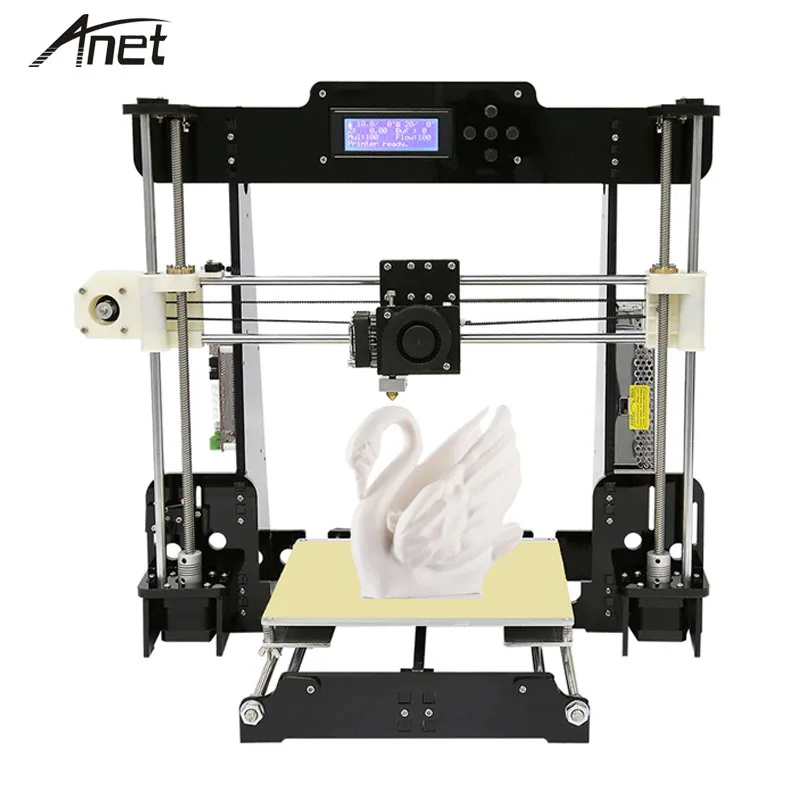
Scroll down to see more on our top picks for the best large format 3D printer, according to many happy buyers.
*Prices listed in this article were as shown in US$ on amazon.com (USA) and other online retailers as of February 2022
1. Best Large 500mm 3D Printer—Crealty Large 3D Printer 500x500x500mm
As one of the 3D printers with the largest printing beds currently available, the Creality CR-10 S5 3D printer has 500x500x500mm of printing space meaning you can really let your imagination run wild.
Installation is super quick and easy as the machine comes in three pre-assembled parts with clearly labeled wires and instructions. Other features include a resume-printing function in the event of loss of power, and you also get a one-year warranty from the manufacturer.
One buyer who gave this machine five stars helpfully mentioned that you need to have plenty of room to accommodate this huge printer, writing, "The main thing to consider is its sheer size. It requires over a yard, possibly a full meter of depth to move the build plate."
BUY NOW: US$719, Creality 3D2. Best Large 400mm 3D Printer—ANYCUBIC 3D Printer 400x400x450mm
A large-format 3D printer from a trusted brand, the ANYCUBIC Chiron is for anyone who doesn't mind spending some extra time and effort on leveling the bed or working out the settings.
Users have reported this as being rather tricky, but the trade-off is a great 400mm 3D printer with impressive capabilities, plus, a superb customer service department that helped with any and all issues pertaining to the printer, from setup to product completion.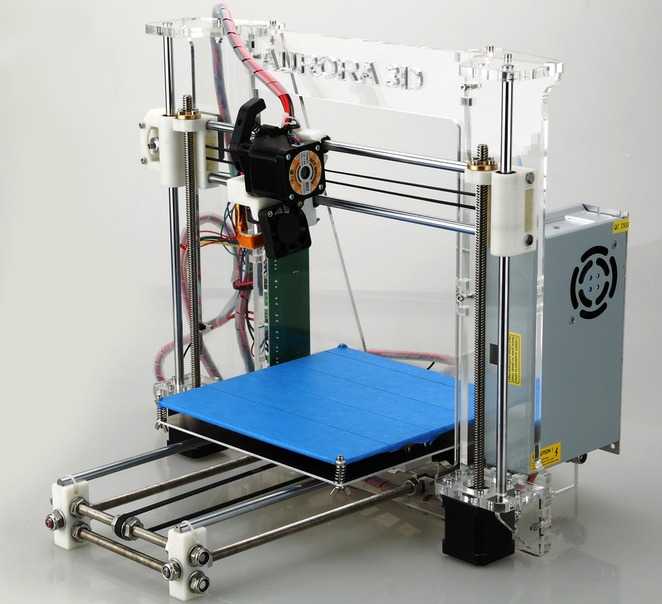 One fan wrote, "It took me a long time to dial in my settings and get high-quality prints but I was able to get the printer working and printing decent quality the same day I put it together."
One fan wrote, "It took me a long time to dial in my settings and get high-quality prints but I was able to get the printer working and printing decent quality the same day I put it together."
Another happy user who has "completed more than 4,000 hours of printing" and "used many hundreds of rolls of filament," described, "The results I am getting are amazing even with some prints taking over 300 hours to complete. In fact, I have just started a seven-part 700-hour print which is going very well."
BUY NOW: US$623.75, Amazon3. Best Large 3D Printer Under $1000—Creality Ender 5 Plus 3D Printer 350x350x400mm
With pretty much the same capabilities as its equally highly-rated sister model, the Creality Ender 5 Pro, including an automatic bed leveling sensor, bed stabilizer, color touch screen, and easy assembly, the Ender 5 Plus has one major difference; its huge size which accommodates its large build plate.
This sturdy thing works straight out of the box, and in addition to great customer support, there is also a massive Creality community to quickly get any answers and assistance you may require.
"I have printed several large helmets with great results," one happy purchaser wrote, and another added, "I love having the bigger print bed for very big projects. There is some fine-tuning you will have to do but after that, you are ready to rock and roll."
BUY NOW: US$599 (Was US$649), Amazon4. Best Industrial Large 3D Printer—Snapmaker 3-in-1 3D Printer 320x350x330mm
For advanced hobbyists or pros who want to up their 3D printing game, the Snapmaker 2.0 will make a proud addition to your workspace and open up a world of 3D opportunity and creativity. In addition to its large printing capacity, it is fast, powerful, and also allows you to do much more than 3D printing, like engraving, cutting, and CNC carving.
At this price, it's a unit for those who are pretty serious about 3D printing, but for small businesses that rely on the craft, it will end up paying for itself in no time. One reviewer who bought this to enhance their graphic design business, wrote, "It's been a valuable asset so far. We are making our own business cards on metal which is super unique and our customers love the added services we can now offer."
Another happy buyer who raved about its versatility and build quality, added, "I have been making non-stop with this machine... [It] allows for the imagination to go absolutely wild with ideas!"
BUY NOW: US$1,799, Amazon5. Best Large 3D Printer under $500—SUNLU S8 3D Printer 310x310x400mm Upgraded
Another good printer with a large print bed, and a tiny price to boot, the upgraded SUNLO S8 only weighs around 26 pounds so is not as much of a task to move as some of the other large 3D printers.
At under US$300, you get many features like high stability, accurate printing, filament runout detection, a Z-axis dual linear rail, and simple assembly. There's also a resume printing function for power failures.
"This printer provides great value for the cost," one buyer explained. "Not only is the print size large enough to do just about anything you can think of, but at 310x310x400 it is the largest in its price class." Another happy customer wrote, "Awesome printer for the price. Can't beat it. It's open-source so it's super easy to add upgrades if you want. Huge build size."
BUY NOW: US$279.99, Amazon6. Best Cheap Large 3D Printer—LONGER LK1 3D Printer 300x300x400mm
With an even smaller price tag, the Longer LK1 3D printer is another option for those wanting to dabble in 3D printing but unsure whether to fork out the big bucks just yet.
It provides plenty of features to learn the art, and the customer service is helpful with any questions you may have. The leveling is not the best, but it is easy to assemble and users have been satisfied with the print quality.
The leveling is not the best, but it is easy to assemble and users have been satisfied with the print quality.
"This is an awesome entry-level printer," one satisfied shopper explained. "I was pleasantly surprised, how easy it was to set up... If you're looking for bang for your buck and [to] familiarize yourself with 3D printing, then don't go wasting money on expensive printers; this one works great."
BUY NOW: US$270.39, WalmartThe Best Large Format 3D Printer—Summary
With one of the largest printing beds currently available for a non-industrial 3D printer, the Creality CR-10 S5 3D printer (US$719, Creality 3D) provides an impressive 500x500x500mm of printing space. The Anycubic Chiron (US$623.75, Amazon) is another large-format printer with impressive capabilities and has a superb customer service department too.
Choosing the Best Large-Format 3D Printer—Buying Guide
With the average printing bed size of a 3D printer intended for general use being around 150–300mm, if you wanted to scale up the size of your 3D creations, a printer of 350mm–500mm would be ideal, and luckily, there are a few worthy large-scale models available on the market for you to choose from.
Benefits of a Large 3D Printer
Development in 3D printing technology means that we've recently been presented with 3D-printed houses, cars, bikes, camper vans, life-size statues, and even sofas and other pieces of furniture.
Obviously, the "large format" we're referring to in this article is less about making grand-scale structures, and more about moving on from miniatures, ornaments, and other small objects or parts that an ordinary, non-industrial-sized 3D printer can produce.
Since you'll have a little more print bed area to play with, with a large-format 3D printer you can create detailed products that don't require a magnifying glass to really appreciate and also larger parts that would otherwise need to be printed in separate sections.
We hope our review of the best large-format 3D printer has been helpful. For more 3D printers and other 3D printing suppliers, including 3D printer filaments suppliers, additive manufacturing suppliers, 3D photographic printing services, and 3D sand printing additive manufacturing, consult our additional guides, or visit the Thomas Supplier Discovery Platform.
- The Best 3D Printers under US$300
- The Best 3D Printers under US$200
- The Best 3D Printer Under US$1000
- The Best 3D Printer Under US$500
- Top 3D Printing Services Companies in the USA
- Origins of 3D Printing and Additive Manufacturing
- Overview of 3D Printing Technologies
- Top 3D Printing Manufacturers and Suppliers (Publicly Traded and Privately-Owned)
- Top Suppliers of Additive Manufacturing Consulting Services
Other Best Product Articles
- The Best Cordless Impact Wrenches
- The Best Portable Generators
- The Best Portable Band Saws
- The Best Electric Space Heaters
- The Best Mini Milling Machine
- The Best Attic Ladders
- The Best Air Purifiers for Smoke
- The Best Circuit Breaker Locator
- The Best Engine Hoists and Accessories
- The Best Drywall Lifts
- The Best Whole-House Generators
- The Best Home Automation Systems
- The Best Quietest Portable Generators
- The Best Uninterruptible Power Supply Systems
- The Best Commercial Patio Heaters
- The Best Electric Bikes
- The Best Electric Pressure Washers
- The Best Keyless Door Locks
- The Best Electric Lawnmowers
- The Best Electric Hand Warmers
More from Custom Manufacturing & Fabricating
Top 10 Resin 3D Printers of 2022 (each price range)
Resin 3D printers use SLA, DLP, or LCD technology to cure liquid resin, producing sharp, high-resolution prints at high speed.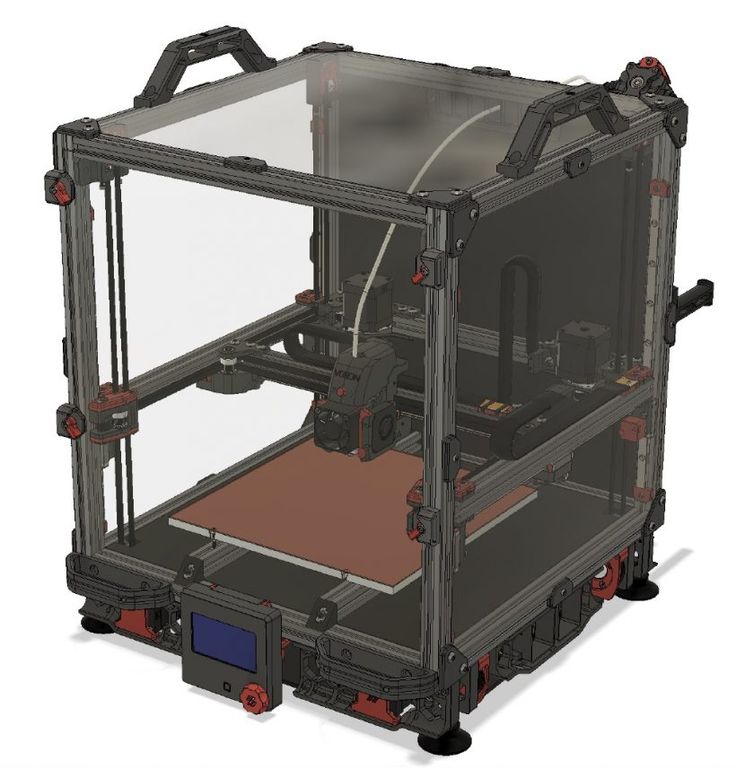 You'd be surprised how many industries use these machines, from jewelry to dentistry.
You'd be surprised how many industries use these machines, from jewelry to dentistry.
That's why we've ranked the best resin printers in every price range, from $150 to $5,000+, so you can find the perfect machine for your hobby projects or business.
Contents
- Best cheap resin 3D printers (under a thousand dollars)
- Anycubic Photon Mono is a great low cost resin 3D printer
- ELEGOO Mars Pro / Mars 2 Pro is the best cheap resin 3D printer
- Anycubic Photon Mono 4K
- Phrozen Sonic Mini 4K
- Elegoo Mars 3
- Elegoo Saturn
- Phrozen Sonic Mighty 4K
- Anycubic Mono X is a great budget photopolymer 3D printer
- Curing and Cleaning Stations
- Anycubic Wash & Cure.
- Elegoo Mercury Plus
- Prusa SL1S Speed
- Peopoly Phenom mSLA Printer - large photoresin 3D printer with huge build volume
- Buyer's Guide - What to Consider When Buying a
- RGB Photopolymer 3D Printer vs.
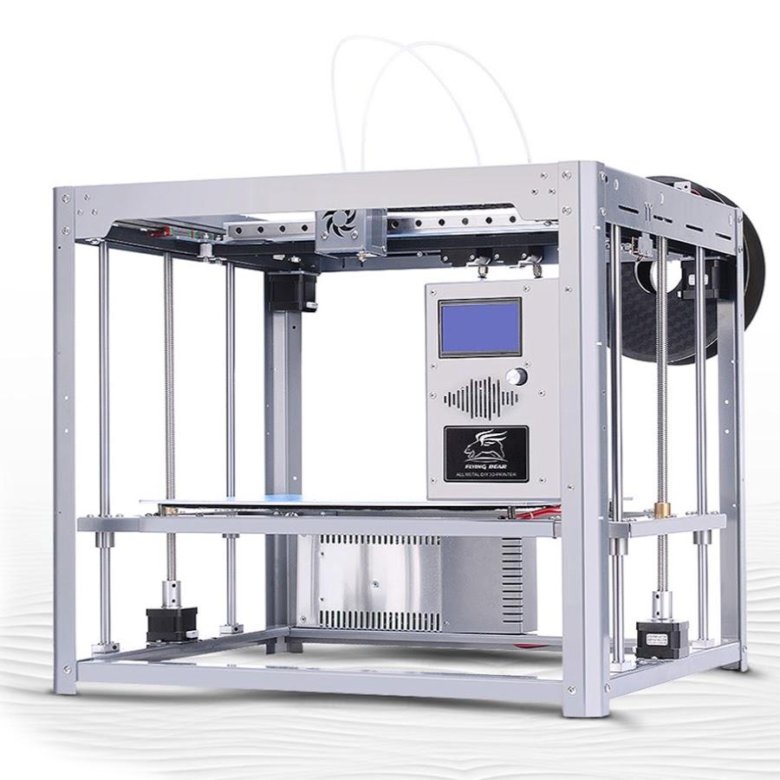 LCD Screens - Differences, Advantages/Disadvantages
LCD Screens - Differences, Advantages/Disadvantages - Post-processing equipment
- How does a photopolymer 3D printer work?
- Resin 3D printing technologies
- SLA
- DLP
- MSLA/LCD
- LFS
- DLS
- How much does a resin 3D printer cost?
- Resin 3D Printer Applications
- Resin 3D Printing vs. Filament (FDM)
- Resin 3D Printing vs Selective Laser Sintering (SLS)
- FAQ
Best cheap resin 3D printers (under a thousand dollars)
Anycubic Photon Mono is a great low cost resin 3D printer
- Price: $249
- Assembly volume: 120 x 80 x 165 mm
- Screen resolution: 2560 x 1620 pixels
- Screen size: 6″ 2K monochrome LCD
- XY resolution: 51 microns
- Speed: 50 mm/h
- Cleaning/Cure: Anycubic Washing and Curing Station
The new Anycubic Photon Mono printer adds to Anycubic's reputation as a premium manufacturer of affordable LCD 3D printers.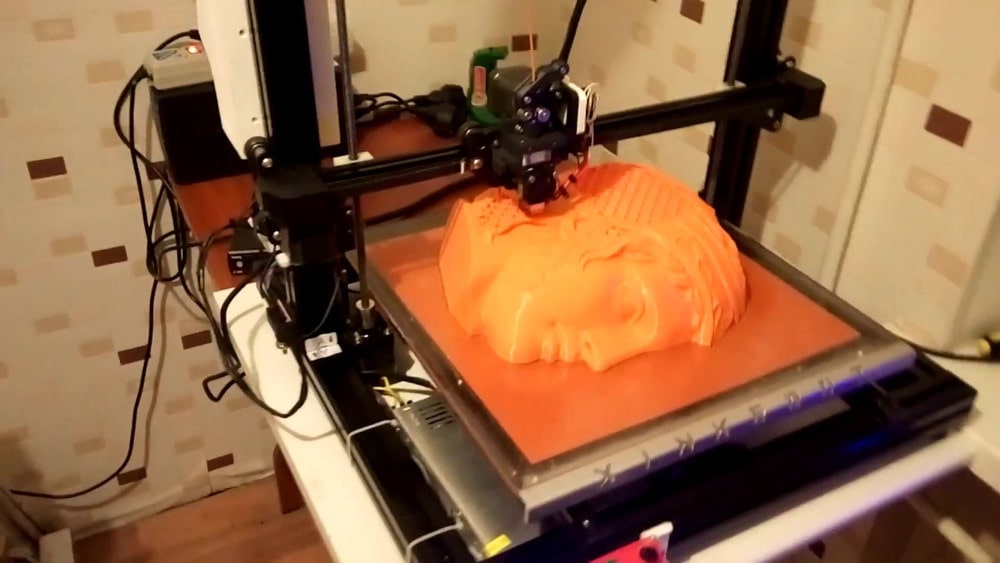 Where you used to pay thousands for an entry-level SLA printer, now printers like the Mono offer great resolution at lower than ever prices. The Photon Mono is a new upgrade from previous models, including greatly increased resin printing speed and other accuracy improvements.
Where you used to pay thousands for an entry-level SLA printer, now printers like the Mono offer great resolution at lower than ever prices. The Photon Mono is a new upgrade from previous models, including greatly increased resin printing speed and other accuracy improvements.
It is equipped with a high quality 2K LCD screen, which is more than enough for most resin projects. But for higher resolution and better quality for really complex figurines or miniatures, we recommend getting the Anycubic Mono X with its 4K LCD screen, which we'll cover in more detail later in this article.
Perhaps the most notable upgrade is speed - up to a maximum of 50mm/h from previous levels of around 20mm/h on older Photon models. Anycubic has also upgraded the Z axis for more stable printing and better surface finish with a new dual linear motion system.
Overall, we rate the Anycubic Photon Mono, as well as its competitors in the Sonic Mini and Elegoo Mars lineups, as the best cheap photopolymer 3D printers. But if you have a few hundred dollars to spare and need a better resolution, go for Mono X.0099 anycubic photon mono cheap photopolymer 3d printer.
But if you have a few hundred dollars to spare and need a better resolution, go for Mono X.0099 anycubic photon mono cheap photopolymer 3d printer.
ELEGOO Mars Pro / Mars 2 Pro - Best Cheap Resin 3D Printer
- Price: $250 / $280 - Available on Amazon here
- Print volume: 129 x 80 x 160 mm
- Screen resolution: 2560 x 1620 pixels
- Screen size: 6.08″ 2K monochrome LCD
- XY resolution: 50 microns
- Speed: 30-50 mm/h
- Cleaning/Cure: Elegoo Mercury Plus/X 9 Wash and Curing Station0010 The
Elegoo Mars is another cheap resin 3D printer, like the Anycubic Photon, which shocked manufacturers with how good it really is. As LCD 3D printing becomes more affordable, accurate and fast, Elegoo is taking advantage of this advantage to create a low cost resin printer that delivers quality and consistency.
An upgraded version of the Mars Pro printer is more precise with an updated Z-axis linear guide system that smoothes layers and makes each individual layer line less obvious, improving surface quality.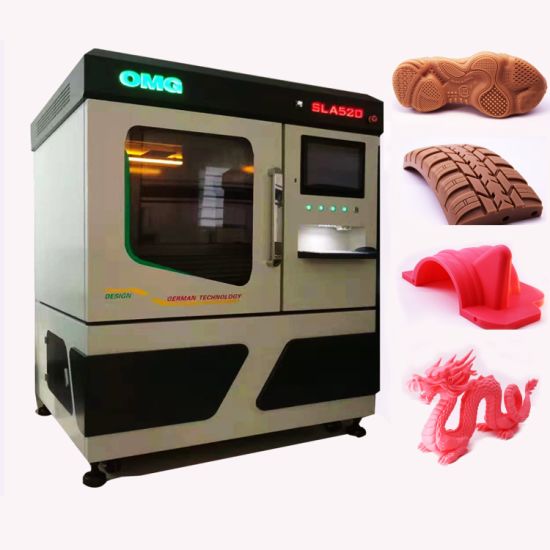 There are also a number of safety improvements, such as a silicone seal that prevents resin from leaking on the 3D printer cover.
There are also a number of safety improvements, such as a silicone seal that prevents resin from leaking on the 3D printer cover.
The printer is equipped with a 2K LCD projector and the minimum layer height is only 0.01mm. Elegoo Mars Pro comes with its own 3D resin slicer called CHITUBOX and has a nice max build volume of 115 x 65 x 150mm. It's also fast enough for a budget photopolymer 3D printer.
Elegoo also sells some of the cheapest resins on the market. You can buy them here.
Anycubic Photon Mono 4K
- Price: $289
- Print volume: 165 x 132 x 80 mm
- Screen resolution: 3840 x 2400
- Screen size: 6.23" 4K monochrome LCD
- XY resolution: 35 microns
- Speed: 50 mm/h
- Cleaning/Cure: Anycubic Washing and Curing Station
Equipped with a 6.23″ 4K high-resolution monochrome LCD, the Anycubic Photon Mono 4K is an affordable, performance-oriented 3D printer for the discerning but budget-friendly resin maker.
The construction volume of 165 x 132 x 80 mm is small by FDM standards. Although, as befits resin 3D printers, its volume is slightly larger than most, and it certainly makes up for it with exceptional precision and detail thanks to its 35 micron XY resolution.
In testing, Anycubic Photon Mono 4K proved to be ready to work with any highly detailed models and decorative elements, even quite large ones. Articulated parts, board game figures and even articulated miniatures, the Mono 4K does it all.
Cast on a few copies of a small part and the Anycubic Photon Mono 4K is ready, making it suitable for small businesses and hobbyists alike. The print speed is up to 50mm/h and the printer easily prints layers in less than 2 seconds.
From a usability standpoint, we'd like to see desirable features such as resume printing and Wi-Fi connectivity. Anycubic's Photon Workshop slicing software is a functional, if unremarkable, slicer. Luckily, the Anycubic Photon Mono 4K's compatibility with third-party software such as Lychee and ChiTuBox means you don't have to be tied to Anycubic's slicing software.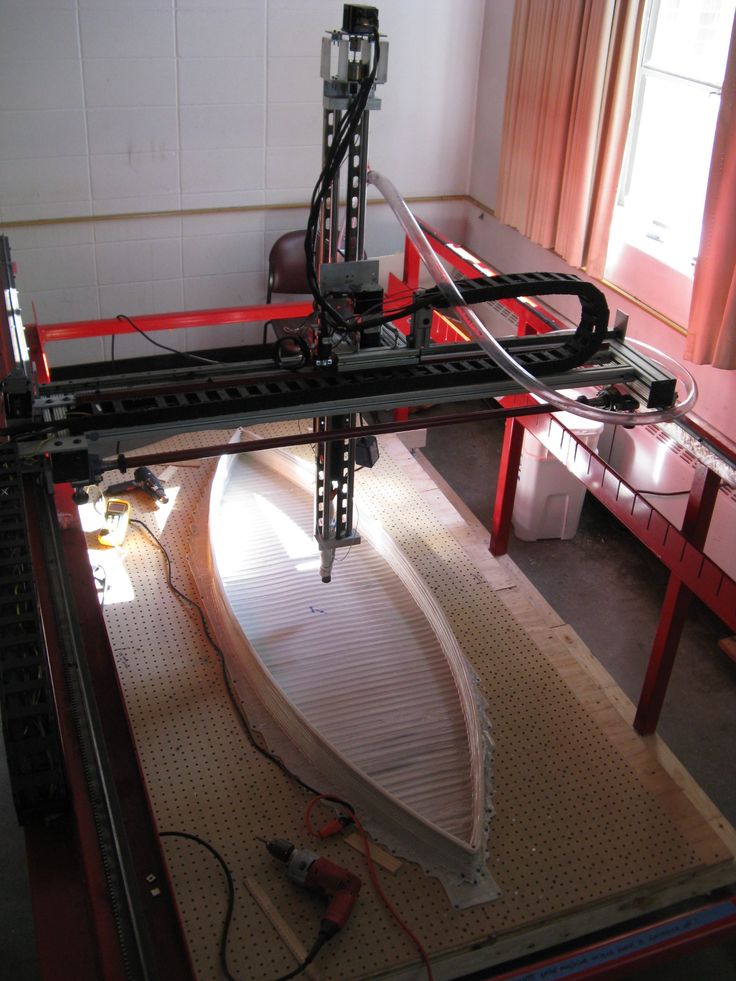
If you're after impressive 4K screen fidelity, the Anycubic Photon Mono 4K's delivers hassle-free, high-resolution printing at a great price.
Phrozen Sonic Mini 4K
- Price: $349 - Available at Phrozen official store here / Available on Amazon here
- Print volume: 134 x 75 x 130 mm
- Screen resolution: 3840 x 2160 pixels
- Screen size: 6.1″ 4K monochrome LCD
- XY resolution: 35 microns
- Speed: 80 mm/h
- Cleaning/Cure: Phrozen Cure and Phrozen Ultra-Sonic Cleaner
At an affordable price, the Phrozen Sonic Mini features a powerful 4K 6.1-inch LCD screen that delivers 35µm quality and two-second layering speed.
This is a powerful, inexpensive photoresin 3D printer with everything you need to print, and while if you need more print volume you can go for the Sonic Mighty 4K (more on that later!), if size isn't a big deal, the Sonic Mini 4K is more than fit.
Phrozen claims the Sonic Mini 4K is ideal for resin mold printers, as well as miniatures and desktop models.
Elegoo Mars 3
- Price: $349
- Print volume: 143 x 90 x 165 mm
- Screen resolution: 4098 x 2560 pixels
- Screen size: 6.6″ 4K monochrome LCD
- XY resolution: 35 microns
- Speed: 1.5-3 seconds per layer
- Cleaning/Cure: Elegoo Mercury Plus/X 9 Wash and Curing Station0010
Featuring an Ultra 4K resolution LCD screen and Elegoo's latest mSLA technology, Elegoo Mars now has 30% more accurate XY (35µm) resolution than Mars 2, as well as a 37% larger build volume. For an extra $100, this is a very attractive deal for those looking to get higher-end resin 3D printing.
Other features include an improved light source for more uniform resin curing - even over a larger build area. Built-in 36 high-power LED lamps and a new lens provide higher accuracy, as well as an improved heat sink and cooling fan, which extends the life of the printer and enhances its durability.
Elegoo Saturn
- Price: $499
- Print volume: 192 x 120 x 200 mm
- Screen resolution: 3840 x 2400 pixels
- Screen size: 8.
 9″ 4K monochrome LCD
9″ 4K monochrome LCD - XY resolution: 50 microns
- Speed: 30-40 mm/h
- Cleaning/Cure: Elegoo Mercury Plus/X Cleaning and Curing Station
Featuring an 8.9" 4K monochrome LCD screen for fast layer curing, the Elegoo Saturn greatly outperforms the standard models by printing 60% faster than the Elegoo Mars Pro, printing a layer every 2-3 seconds.
You get a number of other key improvements for your money, the most notable of which is a larger build area that turns the Elegoo Saturn into a 3D printer for printing large hard resin models, as well as the ability to print multiple small models at the same time in one batch.
Improved precision with the Saturn's double linear Z-axis guide makes the Saturn printer more stable than ever, ensuring accurate and uniform printing. And in case you're a fan, the Elegoo Saturn also has an Ethernet port on the back to keep things fast and efficient.
Phrozen Sonic Mighty 4K
- Price: $549
- Printing area: 200 x 125 x 220 mm
- Screen resolution: 3840 x 2400 pixels
- Screen size: 9.
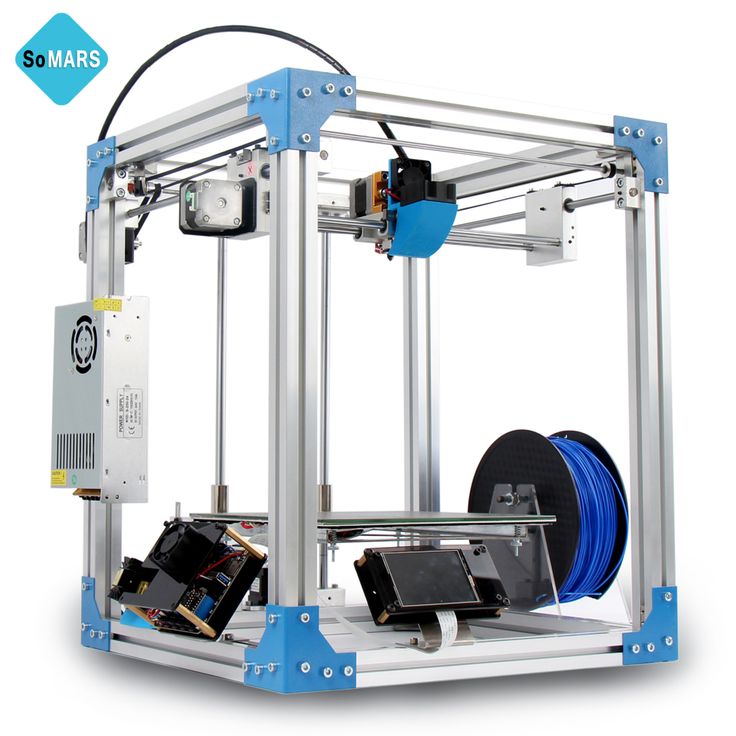 3″ 4K monochrome LCD
3″ 4K monochrome LCD - XY resolution: 52 microns
- Print speed: 80 mm/h
- Cleaning/Cure: Phrozen Cure and Phrozen Ultra-Sonic Cleaner
If you're looking for an affordable resin 3D printer with a large enough footprint for mass production of models or large resin prototypes, the Phrozen Sonic Mighty 4K even outsizes the Elegoo Saturn.
With a strong and reliable Z-axis that delivers print accuracy up to a maximum print height of 22 cm, it offers good print quality, especially with the 4K resolution LCD screen. It also prints fast, with two-second layer printing.
While Phrozen recommends using proprietary 3D printer resins, the Sonic Mighty 4K is compatible with most third-party resins (but check first). So if you have spare resins left over from a previous 3D printer, you should be fine.
Anycubic Mono X is a great budget photopolymer 3D printer
- Price: $599
- Printable area: 192 x 120 x 245 mm
- Screen resolution: 3840 x 2400 pixels
- Screen size: 8.
 9″ 4K monochrome LCD
9″ 4K monochrome LCD - XY resolution: 50 microns
- Speed: 60 mm/h
- Cleaning/Cure: Anycubic Wash & Cure Statio
Anycubic's original budget Photon 3D resin 3D printer is still one of the most popular 3D printers in the world, and now the Mono X proves that the company can compete with higher-end machines. Mono X can print 3 times faster than standard photopolymer printers at speeds up to 60mm/h, and thanks to the 4K LCD screen, it can create very precise and sharp details.
In addition, the upgraded Mono X Z-axis improves stability and makes the surface smooth, unaffected by external factors such as vibrations. The result is jewelry models and miniatures where the layer lines are barely visible.
Another big benefit is WiFi printing, so you don't have to keep unplugging your SD or USB card when printing multiple designs throughout the day. The large 3.5" touch screen makes it easy to navigate, and with a larger build volume, you can print multiple jewelry models or desktop miniatures at the same time. Overall, this is one of the best budget photopolymer 3D printers out there.
Overall, this is one of the best budget photopolymer 3D printers out there.
Curing and Cleaning Stations
Since washing and curing is an inevitable part of resin 3D printing, we have compiled some of the best washing and curing stations to include in your printing system to save you the hassle and mess of subsequent printing. processing.
Anycubic Wash & Cure.
Anycubic Wash & Cure is a versatile station compatible with the vast majority of photoresin printers. Thanks to Anycubic's recent price cut, Wash & Cure is under $100.
The flush mode has adjustable flush cycles including 2, 4 and 6 minutes. Curing mode uses a broad spectrum UV light of 356 nm and 405 nm mounted on a 360° rotating platform to ensure uniform curing of any and all prints 115 x 65 x 165 mm or smaller.
Anycubic has simplified the entire rinsing and curing process with a “set it and forget it” design—select rinsing or curing on the touch button interface and you're done. Station blocks 99.95% UV radiation and has an auto-pause feature if the cap is accidentally knocked off. The station has an adjustable bracket that can be fixed on the Anycubic platform if you are working with a Photon Mono series printer.
Station blocks 99.95% UV radiation and has an auto-pause feature if the cap is accidentally knocked off. The station has an adjustable bracket that can be fixed on the Anycubic platform if you are working with a Photon Mono series printer.
Elegoo Mercury Plus
Another all-in-one station, but this time from Elegeoo, the Elegoo Mercury Plus is an easy-to-use option for hands-free finishing.
The allowed maximum print size is 125 x 85 x 160 mm for washing and 140 x 165 mm for curing. You can either use the included cleaning basket or install the Elegoo build plate with models still attached, making it compatible with most if not all photopolymer 3D printers, not just Elegoo machines.
385nm and 405nm UV lamps and a 360-degree rotatable curing turntable do all the curing work with the ability to enter and control cure times up to 30 minutes on a TFT touch screen. Safety is provided by an anti-UV cap that blocks 99.95% of UV rays and a pause function if the cap comes off during curing.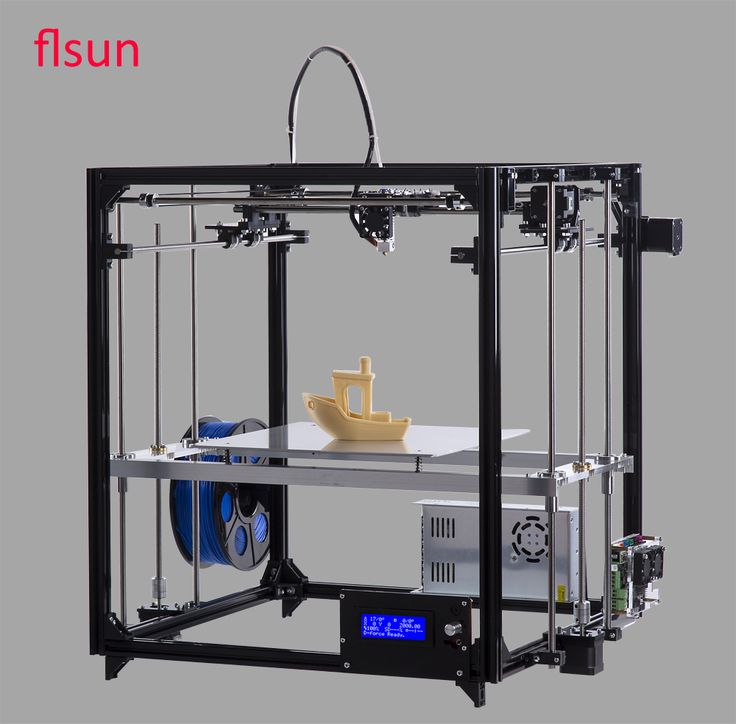
Anycubic station will cost more, but at around $120 you will complete your 3D printing rig with a quality resin 3D printing station with no mess.
Best desktop resin 3D printers ($1,000 to $3,000)
Prusa SL1S Speed
- Price: $1,999 - available at Prusa store here
- Print volume: 120 x 68 x 150 mm
- Screen resolution: 2560 x 1620 pixels
- Screen size: 5.96″ 2K monochrome LCD
- XY resolution: 47 microns
- Print speed: 50 mm/h
- Cleaning/curing: Original Prusa CW1S
Prusa printers are known for being the best RepRap 3D printers. They are so good that over 150,000 printers have been sold, and company founder Josef Prusa has opened his own printer factories to print parts for more printers! Prusa reception.
Prusa has now moved into the SLA 3D printing sector with the launch of the Prusa SL1 printer based on mSLA technology: using LCD and LED panels to cure photosensitive resin layers. As mentioned earlier, this has the advantage of scalability—multiple parts can be created at the same time without additional time—as well as high accuracy.
As mentioned earlier, this has the advantage of scalability—multiple parts can be created at the same time without additional time—as well as high accuracy.
In addition to the printer, Prusa sells a wash and cure machine that helps wash and cure prints, maximizing the surface finish. The Prusa SL1 has a heavy aluminum chassis designed to anchor the printer to the ground and make it more stable for more accurate printing. It seems to me that the phrase “of course, this is good, this is Prusa” is appropriate here.
Peopoly Phenom mSLA Printer - large photopolymer 3D printer with huge build volume
- Price: $1,999 - Available from Matterhackers here
- Print volume: 276 x 155 x 400 mm
- Screen resolution: 3840 x 2160 pixels
- Screen size: 12.5″ 4K LCD
- XY resolution: 72 microns
- Print speed: 75 mm/h
- Cleaning/Cure: Peopoly Curing Box
We already included the Peopoly Moai 130 in our list, a fantastic DIY SLA 3D printer kit.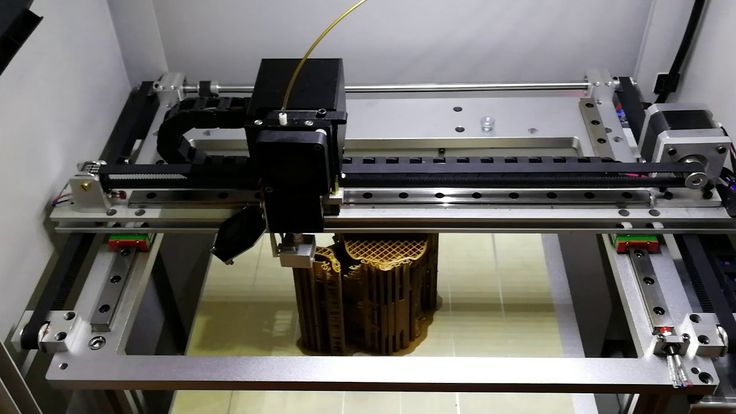 Now Peopoly is back with the Phenom, a large photopolymer 3D printer that combines LCD and LED technology.
Now Peopoly is back with the Phenom, a large photopolymer 3D printer that combines LCD and LED technology.
Peopoly Moai has a huge print volume for a photopolymer 3D printer - 276 x 155 x 400 mm, as well as 72-micron resolution. This is practically unheard of as photopolymer printers typically have a much lower build volume than FDM 3D printers. Peopoly recommends using their own resins for 3D printing, which they sell for about $70 per litre.
Overall, this is an impressive and accurate large format resin 3D printer.
Professional Resin 3D Printers ($3,000+)
Formlabs Form 3 - Best Resin 3D Printer
- Price: $3,499
- Assembly volume: 145 x 145 x 185 mm
- XY resolution: 25 microns
- Print speed: 70 mm/h
- Clean/Cure: Formlabs Form Wash & Cure
Formlabs has made a name for itself in the 3D printing industry since its initial Kickstarter campaign in 2012. An American 3D printer company was selling a Form 3 SLA 3D printer for 3 49$9 and has since become very popular in the dental and jewelry industries.
Formlabs resins available here.
TheForm 3 comes with a ton of new features. It features the new benefits of LFS technology as well as a new Light Processing Unit (LPU) to improve the surface finish of resin parts as well as better layer registration. The Form 2 was already fantastic, and these additional features take the Form 3 to a whole new level in desktop SLA printers.
In addition, the Formlabs Form 3 has an automated resin supply system and uses smart cartridges that automatically fill the resin reservoir, along with many other advanced features. In addition, it is equipped with a resin tray scanning system after each layer and automatically adjusts according to the type of resin used. In addition, the printer has a fantastic touch screen and can be controlled remotely via a WiFi connection.
This UV resin 3D printer has a very good print volume of 145 x 145 x 185mm and is extremely accurate with 25 micron XY resolution. The Formlabs Form 3 is compatible with a wide range of resins, from ceramics, flexible resins, to cast resins, although Formlabs also sells its own high quality resins.
For those looking for 3rd party resins compatible with Formlabs printers, here's a great place to start.
Formlabs has established itself as a leader in stereolithography with the Form 3 printer. It has received rave reviews and is widely used in dentistry. Formlabs also sells a 3D printer for SLS, the Fuse 1.
Buyer's Guide - What to Consider When Buying a Resin 3D Printer
RGB vs. LCD Screens - Differences, Advantages/Disadvantages
earlier models.
This change is only to the benefit of manufacturers, since monochrome screens have many advantages over RGB. Although they are more expensive, they are more efficient, less energy intensive, and print faster due to shorter polymerization times.
Unless you choose an old used model, you will most likely buy a printer with a default monochrome LCD screen.
LCD Resolution - 2K, 4K, 6K
Like computer monitors and TVs, LCD resolution determines the level of pixels and detail.
Higher resolution translates into better XY resolution and lower layer height, which is a critical factor for the fine detail and precision we expect from resin printers.
You'll find 2K, 4K and even 8K resolution printers for those who want the ultimate level of detail and intricate detail in their prints.
However, the print quality of the 2K LCD is far superior to that of FDM printers, so it is more than adequate for most applications.
Build Volume
Photopolymer printers typically have a smaller build volume than more common FDM machines, so manufacturers and professionals use them to create small, intricate parts with high precision.
If you need extra space to print duplicate parts or large figures and models, look to larger format resin printers such as the Peopoly Phenom and Phrozen Sonic Mighty 4K.
Post-Processing Equipment
Resin 3D printing is a messy business and post-processing is a major part of the printing process.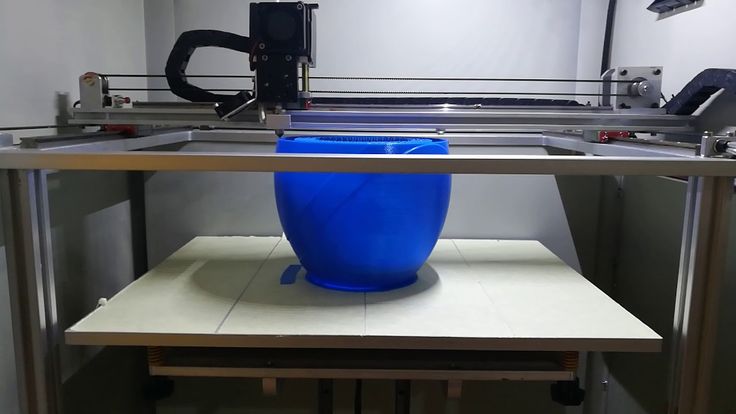 Post-processing consists of two parts - washing and polymerization.
Post-processing consists of two parts - washing and polymerization.
Flushing involves removing uncured resin residue from the print with isopropanol.
Polymerization uses additional UV light to complete the polymerization process to improve the finish and overall rigidity of the part.
Do-it-yourself, hands-on processing is one option, but manufacturers now offer versatile wash and curing stations that eliminate many of the hassles associated with this process.
How does a photopolymer 3D printer work?
Each type of resin 3D printing technology cures UV resin, they just differ in how they do it.
Stereolithography (SLA) was the first additive manufacturing technology invented, with patents granted to 3D Systems back in 1986. SLA printing works by using an ultraviolet laser and mirrors (called galvanometers) to selectively cure the resin.
DLP 3D printing was pioneered by EnvisionTEC and uses a projector similar to a movie theater projector. LCD printing uses an LCD screen with individual LEDs that turn on and off to selectively cure specific areas of the resin to form the final object. LCDs are sometimes referred to as MSLA (masked SLA), as in Prusa and Peopoly resin printers.
LCD printing uses an LCD screen with individual LEDs that turn on and off to selectively cure specific areas of the resin to form the final object. LCDs are sometimes referred to as MSLA (masked SLA), as in Prusa and Peopoly resin printers.
Resin 3D Printing Technologies
SLA
Using mirrors, also called galvanometers, an SLA or stereolithography printer directs a UV laser beam at photopolymer liquid resin in cross sections to cure or print layer by layer.
DLP
DLP, or Digital Light Processing, is very similar to the SLA machine and involves emitting digital light (LED in most printers) through an array of micromirrors onto a light-sensitive liquid resin for flash, or in other words, curing the entire image layer at a time in so-called voxels - rectangles that look like pixels.
MSLA/LCD
Like DLP machines, MSLA or stereolithography (often referred to as LCD) printers use a digital light source (usually hundreds of LEDs) to flash an entire layer at once. Unlike DLP, the MSLA printer uses the LCD as a "mask", directing and illuminating a photosensitive liquid resin rather than mirrors. The mask allows the printer to expose only those areas that need to be cured to the light source.
Unlike DLP, the MSLA printer uses the LCD as a "mask", directing and illuminating a photosensitive liquid resin rather than mirrors. The mask allows the printer to expose only those areas that need to be cured to the light source.
LFS
LFS or Low Force Stereolithography is Formlabs patented pot polymerization technology. LFS overhauls the standard SLA process using a custom-designed Closed Light Processing Unit (LPU) that passes a UV laser beam through a spatial filter and an array of mirrors to polymerize the photosensitive liquid resin cross-section layer by layer.
DLS
Another patented technology from Carbon 3D, DLS, or Digital Light Synthesis, uses an oxygen permeable window to cure a photosensitive liquid resin in what is known as continuous liquid interface manufacturing (CLIP). Light from a special LED engine illuminates ultraviolet rays to match the shape and details of the part's cross-section onto an ultra-thin resin layer supported by an oxygen window known as the "dead zone". The resin in the "dead zone" is then cured to create precise, detail-rich layers.
The resin in the "dead zone" is then cured to create precise, detail-rich layers.
How much does a photopolymer 3D printer cost?
Good cheap photopolymer 3D printers start at around $200. Even ten years ago, resin printers cost thousands of dollars, but with great advancement - mainly in the field of LCD printing - the prices have come down!
However, these budget photoresin 3D printers can't compete with more professional high resolution printers like the Form 3 ($3,499) or the Peopoly Phenom (1 9$99). They can still produce accurate models, for example for miniatures and other fun projects, but as a photopolymer 3D printer for business, they may not be effective.
Photopolymer 3D printer applications
Budget photopolymer 3D printers are commonly used by hobbyists to produce precise figurines and miniatures in detail that FDM printers simply cannot match. They are commonly used for 28mm miniatures, D&D figurines and other similar desktop model projects.
However, these inexpensive options can sometimes be used to create wax molds for casting jewelry. However, for higher quality precious metal casting, it is recommended to use a more professional resin 3D printer capable of better resolution and precision.
photopolymer printers are widely used in dentistry, audiology, jewelry and medical industries. For example, in dentistry, photopolymer 3D printers can print orthodontic models and implants, and in audiology, almost 100% of custom-made hearing aids are now 3D printed.
3D resin versus filament (FDM)
Hobbyists usually turn to resin 3D printing when they want higher precision, smoother surfaces and sharper details on small prints such as figurines or miniatures. While FDM is simpler, it cannot achieve these levels of precision and smoothness.
However, the trade-off between FDM and resin is that in terms of filament to resin ratio, filaments are cheaper, easier to use and reuse, come in more materials, colors and types, and tend to be stiffer.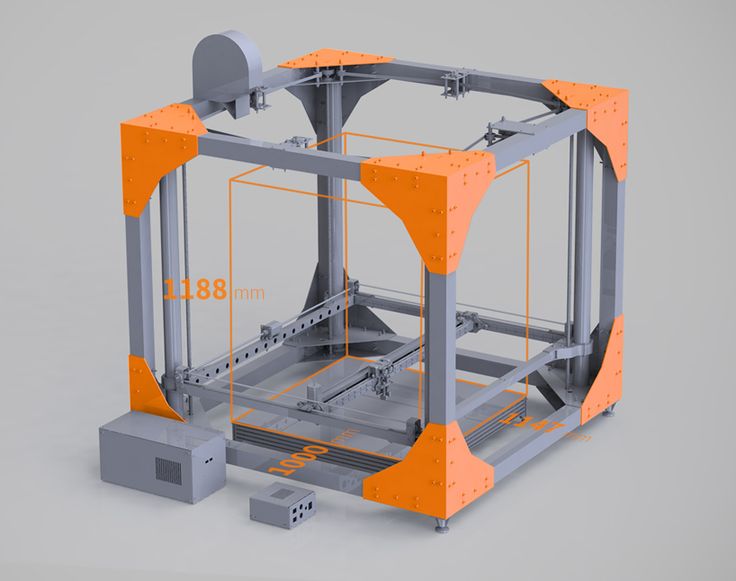
Resins tend to be more expensive (although LCD resins are much cheaper now) and harder to use. They require thorough rinsing and post-processing, and extra care must be taken when printing and during post-processing with a resin 3D printer, including wearing protective gear, as the materials can be corrosive.
Thus, resin and thread are used for different purposes, and are not in direct competition for the same use. For the unrivaled precision of cheap 3D printers, as well as the rapid production of dental, jewelry and medical models, resin 3D printers are the way to go. But for more complex - perhaps with multiple colors - basic prototypes, deposition modeling is best suited.
Anti-selective laser sintering (SLS) resin 3D printing
The trade-off between SLA and selective laser sintering is similar: SLS-printed parts are more rigid, with excellent mechanical properties (and make excellent functional prototypes), although parts printed SLA are characterized by a smoother surface and faster printing.
SLS is also great if you're not a fan of additional support structures and don't like post-processing, because the parts printed in the resin powder chamber don't move or deform during printing. SLS offers better material properties than SLA - for example, it is not as susceptible to UV or sun damage. But they are less affordable—even the cheapest printers start at $5,000.
FAQ
Is resin more durable than PLA?
In general, conventional resin produces brittle, brittle parts that are less resistant to stress and weather than traditional 3D printing materials such as PLA. Therefore, we cannot recommend the resin for making load-bearing, functional, impact-resistant or exterior parts where PLA and ABS work much better, so manufacturers prefer the resin for fragile decorative parts filled with precise detail and a smooth finish.
Increasingly, however, 3D printing media manufacturers are offering "tough" resins such as Formlabs Tough 2000 Resin, which offer superior tear strength and even outperform ABS in some cases. Real world applications in orthopedics (such as splints and braces) and dentistry (aligners and crowns) demonstrate how people are increasingly turning to tough resins to make strong, wear-resistant parts.
Real world applications in orthopedics (such as splints and braces) and dentistry (aligners and crowns) demonstrate how people are increasingly turning to tough resins to make strong, wear-resistant parts.
Is 3D printer resin expensive?
When viewed in the context of 3D printing and compared to other popular materials and filament types, resin is not particularly expensive. A 1 liter bottle of standard resin costs between $20 and $50 depending on the brand, which is more or less the price of ABS and PLA raw materials.
The number and size of prints you can make from a standard 1 liter bottle can vary, with costs skyrocketing for the most prolific producers.
Is the resin print dirty?
While the resin printing process itself isn't messy, post-processing of the finished print is invariably an annoying, sloppy mess, not to mention a potentially dangerous mess of dripping resin and harsh isopropanol.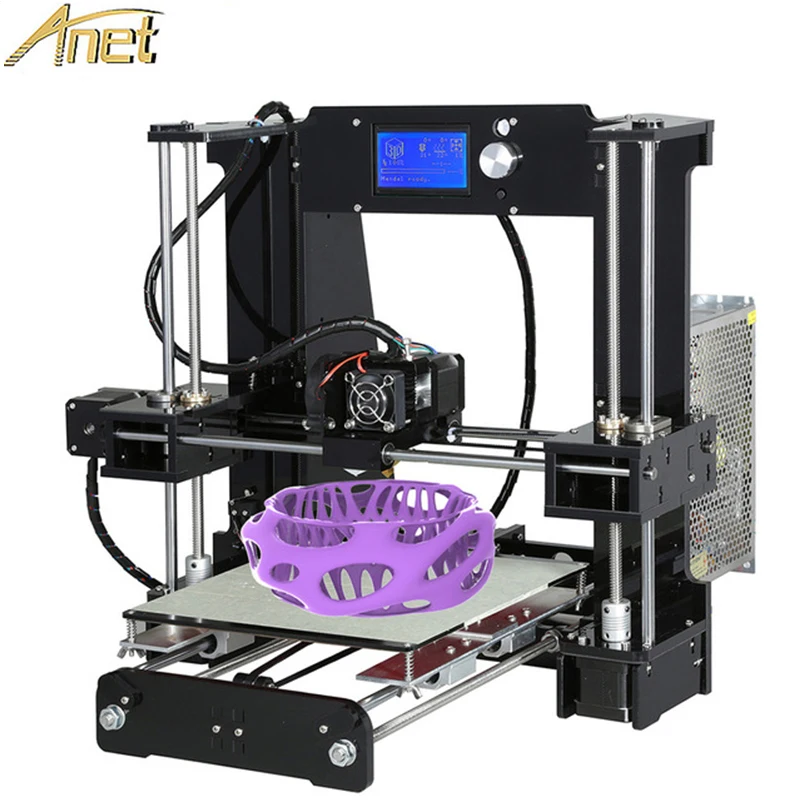 This is not for the faint of heart and not for those who are afraid to get involved in this matter.
This is not for the faint of heart and not for those who are afraid to get involved in this matter.
Luckily, curing and cleaning stations help keep resin processing messy, so you don't get your hands dirty by smearing prints in a vat of isopropanol.
Do resin prints need to be rinsed and cured?
Yes. The resin printing process leaves uncured resin residue on the finished part. Washing off excess resin ensures that all the details and finish of the print remain accurate when you move on to the polymerization process. It's also a safety issue: washing the resin prints removes potentially toxic, uncured liquid resin, allowing the part to be handled safely.
Curing is an equally important part of the process. When the printer has finished printing the part, the resin is in a transitional state: it is hard enough to retain the desired shape and detail, but lacks overall rigidity, making it prone to scratches, scarring, and imperfections. Curing the print with UV, or even sunlight if you have time, allows you to reach the optimal, finished resin state.
Curing the print with UV, or even sunlight if you have time, allows you to reach the optimal, finished resin state.
3D printers 2021, low cost 3D printer rankings The list will include the best-selling devices in two price ranges (up to 30 tr and up to 60 tr). Printers working with both plastic filament (FDM) and photopolymers (LCD/DLP) will be presented. This list will always be up to date, as it is periodically updated and supplemented.
Last updated March 12, 2021
Contents:
Inexpensive FDM 3D printers from 15 000 rub. - up to 30 000 rub.
Inexpensive FDM 3D printers from 15 000 rub. - up to 30 000 rub.
Budget photopolymers - up to 60,000 rubles.
1.
Anycubic Mega Zero .
Chamber: 220 x 220 x 250 mm
Print technology: FDM
Layer thickness: 100 microns
Model year: 2020
the damage to quality, but rather the opposite, is compensated by better components and thoughtful design. The adage that "less is more" fits perfectly with this printer. Many will object and say that it does not have a heated platform, but if you look at it from a pragmatic side, then Mega Zero shows excellent results in printing with PLA and TPU plastic (the variety of types and colors of which just rolls over).
The adage that "less is more" fits perfectly with this printer. Many will object and say that it does not have a heated platform, but if you look at it from a pragmatic side, then Mega Zero shows excellent results in printing with PLA and TPU plastic (the variety of types and colors of which just rolls over).
Cost: 16 480
Order
2.
Anycubic Mega S .
Working camera: 210 x 210 x 205 mm
Print technology: FDM
Layer thickness: 100 μm
Model year: 2018
Another wonderful, inexpensive printer in the line of this Chinese manufacturer is Anycubic Mega S . The machine has an all-metal body. Simple and rigid frame, high quality printing stability. In addition to the beautiful design and full-color touch screen, Mega S boasts a fairly large build area in its class, which is 210x210x205 mm. The 3D printer is equipped with the already famous Anycubic Ultrabase heated platform. This means that the print will be well glued to the table during printing and can be easily removed when it is completed.
This means that the print will be well glued to the table during printing and can be easily removed when it is completed.
Cost: 24 490
Order
3.
Anet ET4 .
Working camera: 220 x 220 x 250 mm
Print technology: FDM
Layer thickness: 100 μm
Model year: 2019
Anet ET4 - a modern 3D printer with an integral design and an integral design and an integral design and display 2.8 inches. One of the fat pluses is the automatic calibration of the platform by 25 points. ET4 will notify you in advance if the filament is running out, and will also resume operation in case of an emergency power outage, without compromising print quality. The printer is equipped with Trinamic stepper drivers, thanks to which the machine is able to print almost silently, even at the highest speed.
Cost: 19 900
Order
4.
Two Trees Bluer .
Working chamber: 230 x 230 x 280 mm
Print technology: FDM
Layer thickness: 100 microns on the market, perfect for getting started with 3D printing. It provides great opportunities for home experimentation, learning and prototyping. Supplied as a self-assembly kit. Despite the low price, this model can offer high print quality and out of the box it has quite serious characteristics: “quiet” drivers, a heated table, double-sided airflow, a thread break sensor and a 32-bit control board.
Cost: 21 900
Order
5.
Creality Ender 3 .
Working camera: 220 x 220 x 250 mm
Print technology: FDM
Layer thickness: 100 μm
Model year: 2017
Crealy Ender 3 - is one of the most popular 3D printers On the market. For its reliability and simplicity, in the world of 3D printing it is compared to a Kalashnikov assault rifle. It has a working volume of 220 x 220 x 250 mm, a heated desktop, a print emergency recovery mode, and supports flexible plastics. The combination of these characteristics is not even in some, more expensive printers. Ender 3 is easy and quick to assemble. The Creality Ender 3 is a great 3D printer for beginners and is one of the best value printers out there. Ready to print right out of the box, and thanks to the rapidly growing community of owners of this 3D printer, it has a huge number of add-ons and upgrades.
It has a working volume of 220 x 220 x 250 mm, a heated desktop, a print emergency recovery mode, and supports flexible plastics. The combination of these characteristics is not even in some, more expensive printers. Ender 3 is easy and quick to assemble. The Creality Ender 3 is a great 3D printer for beginners and is one of the best value printers out there. Ready to print right out of the box, and thanks to the rapidly growing community of owners of this 3D printer, it has a huge number of add-ons and upgrades.
Cost: 20 500
Order
6.
Creality Ender 3 v.2 .
Working chamber: 220 x 220 x 250 mm
Print technology: FDM
Layer thickness: 100 microns
Model year: 2020 Excellent print quality right out of the box without additional settings and upgrades. It has a beautiful external design, almost silent stepper drivers, a 32-bit motherboard. Hardened glass platform with carborundum coating. Most cheap 3D printers have hideous and awkward displays, but the Ender 3 v.2 comes with a color screen. It is also worth noting that the new model has a lot of minor, but pleasant improvements. For example, a drawer for tools or interchangeable nozzles. Another useful option is the belt tensioner, which can be used to easily increase the tension of a stretched belt.
Most cheap 3D printers have hideous and awkward displays, but the Ender 3 v.2 comes with a color screen. It is also worth noting that the new model has a lot of minor, but pleasant improvements. For example, a drawer for tools or interchangeable nozzles. Another useful option is the belt tensioner, which can be used to easily increase the tension of a stretched belt.
Cost: 20 500
Order
7.
Wanhao D12 230 .Printing technology: FDM The model offers advanced printing options with two MK12 extruders. Print models with two colors of plastic or complex products with soluble supports. The high heating temperature of the extruder makes it compatible with all plastics with melting points up to 260°C. High torque filament feeding system and 360° cooling ensure high quality printed models.
Cost: 25 900
Order
1.
 Anycubic Chiron .
Anycubic Chiron .
Working chamber: 400 x 400 x 450 mm
Print technology: FDM 400 x 450 mm. The Ultrabase Pro desktop is a heavy-duty glass with a perforated overlay that perfectly holds prints when heated, and easily "releases" when cool. The frame is made of aluminum profiles, fixed with metal T-shaped plates. At the base of the 3D printer there is a standard power supply with an LCD display and a Trigorilla MOSFET motherboard.
Cost: 41 900
Order
2.
Artillery Genius .
Working camera: 220 x 220 x 250 mm
Print technology: FDM
Layer thickness: 50 μm
Model: 2019
Artillery Genius Popular, budget 3D printer, with a 220 x 220 x 220 x 220 area 250 mm. The device is equipped with a heated Ultrabase platform with an increased heating temperature up to 100°C. The platform is calibrated manually using four points, but at the same time, the manufacturer provided the opportunity to upgrade and install touch sensors for automatic platform leveling. The extruder uses a direct plastic feed mechanism, which makes it possible to print flexible materials such as TPU. Thanks to the ultra-quiet stepper drivers, Genius boasts near-silent operation, which is very important for extended use at home.
The extruder uses a direct plastic feed mechanism, which makes it possible to print flexible materials such as TPU. Thanks to the ultra-quiet stepper drivers, Genius boasts near-silent operation, which is very important for extended use at home.
Cost: 31 900
Order
3.
Artillery Sidewinder X1 .
Working chamber: 300 x 300 x 400 mm
Print technology: FDM
Layer thickness: 50 microns but due to the quality of this model has a good potential. The device consists of modules and is delivered assembled for 95%. It is equipped with a heated platform covered with perforated glass and a large print area measuring 300x300x400 mm. You really enjoy working with the printer. Prints great, although it needs some minor adjustments before launch.
Cost: 38 900
Order
4.
BIQU B1 .
Working chamber: 235 x 235 x 270 mm
Print technology: FDM
Layer thickness: 50 µm
Model Year: 2020
Biqu is a brand of BigTreeTech, a well-known manufacturer of 3D printer accessories and components, especially for the Ender 3 series. The Biqu B1 is essentially an improved clone of the Ender 3. It has a substantially higher print volume of 235 x 235 x 270 mm, Y-adjustable belt tensioner and compact unit.
The Biqu B1 is essentially an improved clone of the Ender 3. It has a substantially higher print volume of 235 x 235 x 270 mm, Y-adjustable belt tensioner and compact unit.
Cost: 31 900
Order
5.
Flashforge Adventurer 3 .
Working chamber: 150 x 150 x 150 mm
Print technology: FDM
Layer thickness: 50 microns
Model year: 2018 institutions. It has a completely closed print chamber, a built-in camera for remote control of the print process, a convenient removable platform. If you are interested in 3D printing, this machine is a great choice. The design is quite discreet and will fit well in a school, office or workshop. All in all, a great all-round printer.
Cost: 40 900
Order
6.
QIDI Tech X-Maker .
Working chamber: 170 x 150 x 150 mm
Print technology: FDM
Layer thickness: 50 µm start printing immediately after unpacking. It has a pleasant and modern appearance, thanks to the closed print chamber it is quite silent. You will appreciate the convenient mounting of the coil, as well as features such as Wi-Fi connection, a thermal camera with removable panels and a cover, the ability to print on a flexible removable magnetic table, which, after being removed, only need to be bent to separate the product.
It has a pleasant and modern appearance, thanks to the closed print chamber it is quite silent. You will appreciate the convenient mounting of the coil, as well as features such as Wi-Fi connection, a thermal camera with removable panels and a cover, the ability to print on a flexible removable magnetic table, which, after being removed, only need to be bent to separate the product.
Cost: 40 900
Order
1.
Phrozen Sonic Mini 4K .
Working chamber: 135 x 75 x 130 mm
Print technology: LCD
Layer thickness: 10 microns
Model year: 2020 with ultra high resolution 772 PPI. The device provides 4K resolution printing with a layer thickness of 35 microns and a total print area of 155 mm. These parameters allow you to grow highly detailed 3D models that will accurately fit the 3D design, regardless of size. Using a monochrome LCD display, the Sonic Mini 4K can print one layer in two seconds. The screen resource is more than 2,000 hours of operation.
The screen resource is more than 2,000 hours of operation.
Cost: 39 900
Order
2.
Anycubic Photon Mono .
Working camera: 130 x 80 x 165 mm
Print technology: LCD
layer thickness: 10 μm
Model year: 2020
Anycubic Photon Mono is equipped with a model of 130 x 80 x 165 mm. The minimum layer print resolution is adjustable from 10 to 15 microns. These settings allow Photon Mono to cure a layer in 1.5 seconds, and print speeds are twice as fast as the previous generation printer. In addition, the next-generation UV sensor provides a more even distribution of light, which greatly improves print quality. The new, well-designed cooling system also contributes to increased stability.
Cost: 29 900
Order
3.
Anycubic Photon Mono SE .
Working chamber: 130 x 78 x 160 mm
Print technology: LCD
Layer thickness: 10 µm
Model year: 2020
90 speed print and resolution. This technology is becoming more and more popular, so Anycubic put their new budget model Photon Mono SE on the pedestal. As a light source, the printer is equipped with a six-inch 2K monochrome LCD (2560 x 1520 Px). This resolution allows to achieve an accuracy of 51 microns in the XY axis, and 10 microns in the Z axis. The device is also equipped with a matrix with a parallel light source, which contributes to a more uniform effect and better dissipates heat.
This technology is becoming more and more popular, so Anycubic put their new budget model Photon Mono SE on the pedestal. As a light source, the printer is equipped with a six-inch 2K monochrome LCD (2560 x 1520 Px). This resolution allows to achieve an accuracy of 51 microns in the XY axis, and 10 microns in the Z axis. The device is also equipped with a matrix with a parallel light source, which contributes to a more uniform effect and better dissipates heat. Cost: 42 900
Order
4.
Qidi Tech Shadow 5.5 S . Layer Thickness: 10 µm in a stylish case. QIDI Shadow 5.5s has a unique dual rail with double lock, equipped with 4 optical axis structures, for a more accurate and stable printing process. The walls of the printer are made of high-strength tempered glass with a built-in 2K LCD screen. The high-quality LCD screen ensures that the material is quickly cured by UV radiation, and the accuracy and printing result are improved.